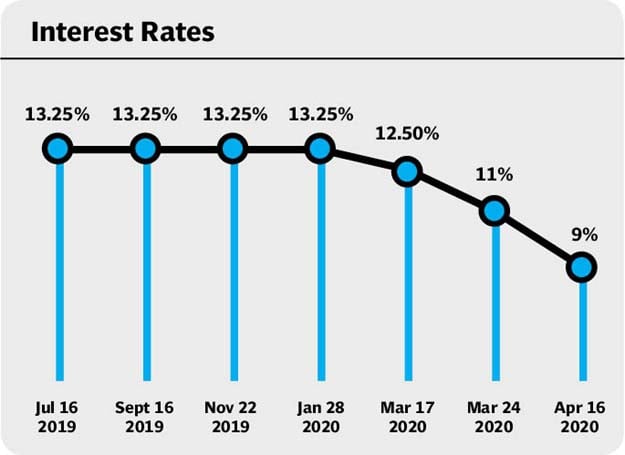
With this, the central bank has cut the policy rate by a cumulative 425 basis points in the past one month to ease the pressure of interest payment as a majority of businesses stay closed under the lockdown due to the coronavirus pandemic. Otherwise, the central bank’s monetary policy committee (MPC) meets after every two months to determine the interest rate corridor.
Earlier, the SBP allowed businesses and people to defer payment of bank loan principal for one year, but they would continue to pay interest money against the loans.
Global and domestic economic growth outlooks have become negative in response to the Covid-19 crisis. The fast worsening situation led the MPC to hold an emergency meeting to cut the rate significantly, according to the central bank. With the interest rate now in single digit, the “forward-looking real interest rate (defined as the policy rate less expected inflation) stands at around zero, which is about the middle of the range across most emerging markets,” the SBP said in the latest monetary policy statement on Thursday.
“The MPC was of the view that this action would cushion the impact of the coronavirus shock on growth and employment, by easing borrowing costs and the debt service burden of households and firms, while also maintaining financial stability. It would also help ensure that economic activity is better placed to recover when the pandemic subsides.”

GDP to shrink after 68 years
“The economy is expected to contract by 1.5% in FY20,” the central bank said, which had projected a growth of 3% in the second half of March when infection cases started rising in Pakistan.
Such a negative growth in the national economy will come after a gap of 68 years. Last time, Pakistan recorded negative economic growth in 1951-52. The economic growth would, however, recover to around 2% in FY21, the SBP stated. Besides, inflation is expected to be close to the lower end of the previously announced 11-12% range in the current fiscal year and would fall to a 7-9% range next fiscal year, the SBP pointed out.
“While there are some upside risks to the headline inflation in case of temporary supply disruptions or food price shocks, these are unlikely to generate strong second-round effects due to weakness of the economy.
Similarly, the inflationary impact of the recent (rupee-dollar) exchange rate depreciation is expected to be contained given low import demand and falling global prices.” Since the last MPC meeting, held on March 24, the global and domestic outlook has further deteriorated.
“Domestically, high-frequency indicators of activity – including retail sales, credit card spending, cement production, export orders, tax collection, and mobility data from Google’s recently introduced community mobility reports – suggest a significant slowdown in most parts of the economy in recent weeks.
“On the inflation front, both the March CPI (Consumer Price Index) and more recent weekly SPI (Sensitive Price Indicator) release in April also show a marked reduction in the inflation momentum,” it said. Similarly, the world economy is expected to enter into the sharpest downturn since the Great Depression, contracting by 3% in 2020, according to projections released this week by the IMF, the SBP said.
“This is a much deeper recession than the 0.07% contraction during the global financial crisis in 2009. Moreover, there are severe risks of a worse outcome. Besides, global oil prices have plummeted further, with futures markets suggesting low prices will persist,” it said.
“The MPC highlighted that this rate cut would complement other measures recently taken by the SBP to support the economy, including concessional financing to companies that do not lay off workers, one-year extension in principal payments, doubling of the period for rescheduling of loans from 90 to 180 days, and concessional financing for hospitals and medical centres incurring expenses to combat the coronavirus pandemic,” it added.
Published in The Express Tribune, April 17th, 2020.
Like Business on Facebook, follow @TribuneBiz on Twitter to stay informed and join in the conversation.









































COMMENTS
Comments are moderated and generally will be posted if they are on-topic and not abusive.
For more information, please see our Comments FAQ